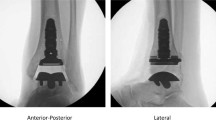Abstract
The poor results of total ankle replacement have been attributed to the inability of designers to restore adequately the critical mutual function of the ligaments and the articular surfaces. The purpose of this study was to design sagittal shapes of the articular surfaces for a new ankle prosthesis to be compatible with the geometry of the reticular surfaces for a new ankle prosthesis to be compatible with the geometry of the retained ligamentous structures. Several ligament-compatible pairs of articular surfaces were tested using a computerised version of a four-bar linkage model. The kinematics of the ankle when replaced by non-conforming two-component and by fully conforming three-component designs with either flat, concave or convex tibial surfaces were assessed by the model. A ligament-compatible convex-tibia fully-congruent three-component prosthesis showed the best features. The three-component prosthesis allows complete congruence over the entire range of flexion. A convex shape for the tibial are was preferred because of the better degree of entrapment of the meniscal bearing. A 5 cm convex-tibia arc radius gave 2 mm entrapment together with 9.8 mm of tibial bone cut. Ligament elongation imposed by full congruence of the articular surfaces was less than 0.03% of the original length. The original patterns of joint kinematics and ligament tensioning are closely restored in the joint replaced by the proposed prosthesis.
Similar content being viewed by others
References
Alexander, I. J., andChao, E. Y. S. (1991): ‘Biomechanics’ inMorrey, B. F. (Ed.): ‘Joint replacement arthroplasty’ (Churchill Livingstone, New York), Chap. 90, pp. 1149–1155
Barnett, C. H. andNapier, J. R. (1952): ‘The axis of rotation at the ankle joint in man: its influence upon the form of the talus and mobility of the fibula’,J. Anatomy,86, pp. 1–9
Bentley, G., andShearer, J. R. (1996): ‘The foot and ankle’ inDuthie, R. B., andBentley, G. (Eds): ‘Mercer's orthopaedic surgery’ (Arnold, London), Chap. 17, pp. 1193–1253
Buechel, F. F., Pappas, M. J., andIorio, L. I. (1988): ‘New Jersey low contact stress total ankle replacement: Biomechanical rationale and review of 23 cements cases’,Foot Ankle,8, pp. 279–290
Engh, G. A., Kimberly, A. D., andHanes, C. K. (1992): ‘Polyethylene wear of metal-backed tibial components in total and unicompartmental knee prostheses’,J. Bone Jt. Surg. [Br] 74B, pp. 9–17
Giannini, S., Leardini, A., andO'Connor, J. J. (2000): ‘Total ankle replacement: review of the designs and of the current status’,Foot Ankle Surg.,6, pp. 77–88
Goodfellow, J. W., andO'Connor, J. J. (1978): ‘The mechanics of the knee and prosthesis design’,J. Bone Jt. Surg. [Br],60B, pp. 358–369
Goodfellow, J. W., andO'Connor, J. J. (1992): ‘The anterior cruciate ligament in knee arthroplasty: a risk factor with unconstrained meniscal prosthesis’,Clin. Orth. Rel. Res.,276, pp. 245–252
Goodfellow, J. W., andO'Connor, J. J. (1994): ‘The role of congruent meniscal bearings in knee arthroplasty’ inScott, W. N. (Ed.): ‘The knee’ (Mosby, St. Louis), Part XIV, Vol. 2, Chap. 63, pp. 1143–1156
Hamblen, D. L. (1985): ‘Can the ankle joint be replaced?’,J. Bone Jt. Surg. [Br],67B, pp. 689–690
Kitaoka, H. B. (1991): ‘Historical perspective of foot and ankle arthroplasty’ inMorrey, B. F. (Ed.): ‘Joint replacement arthroplasty’ (Churchill Livingstone, New York), Chap. 91, pp. 1157–1172
Kitaoka, H. B., andPatzer, G. L. (1996): ‘Clinical results of the Mayo total ankle arthroplasty’,J. Bone Jt. Surg.,78A, pp. 1658–1664
Kofoed, H. A. (1986): ‘A new total ankle joint prosthesis’ inKossowky, R., andKossowsky, N. (Eds): ‘Material sciences and implant orthopaedic surgery’ (Martinus Nijhoff, Dordrecht), pp. 75–84
Lachiewicz, P. F. (1994): ‘Total ankle arthroplasty: indications, techniques, and results’,Orthopaedic Rev. 23, pp. 315–320
Leardini, A., Catani, F., Petitto, A., Giannini, S., andO'Connor, J. J. (1998): ‘Fibre recruitment and articular contact at the ankle by an accurate 3D measurement system’. Trans. 8th Conf. European Orthopaedic Research Society, Amsterdam
Leardini, A., O'Connor, J.J., Catani, F., Stagni, R., andGianni, S. (1999a): ‘Lever arm lengths of the flexor and extensor muscles at the ankle joint complex’. Proc. 45th Annual Meeting of Orthopaedic Research Society, Anaheim (CA)
Leardini, A., O'Connor, J. J., Catani, F., andGiannini, S. (1999b): ‘Kinematics of the human ankle complex in passive flexion—a single degree of freedom system’,J. Biomech. 32, pp. 111–118
Leardini, A., O'Connor, J. J., Catani, F., andGiannini, S. (1999c): ‘A geometric model of the human ankle joint’,J. Biomech.,32, pp. 585–591
Lewis, G. (1994): ‘The ankle joint prosthetic replacement: clinical performance and research challenges’Foot Ankle,15, pp. 471–476
Murray, D. W., Goodfellow, J. W., andO'Connor, J. J. (1998): ‘The Oxford medial unicompartmental arthroplasty: a ten-year survival study’,J. Bone Jt. Surg. [Br] 80B, pp. 983–989
O'Connor, J. J., Shercliff, T. L., Biden, E., andGoodfellow, J. W. (1989): ‘The geometry of the knee in the sagittal plane’Proc. Inst. Mech. Eng. Part H, J. Engng. Med.,203, pp. 223–233
Psychoyios, V., Crawford, R. W., O'Connor, J. J., andMurray, D. W. (1998): ‘Weaf of congruent meniscal bearings in unicompartmental knee arthroplasty’J. Bone Jt. Surg. [Br],80B, pp. 976–982
Reimann, R., Anderhuber, F., andGerold, J. (1986): ‘Geometrical shape of the human trochlea tali’,Acta Anatomica,127, pp. 271–278
Rush, J. (1996): ‘Management of the rheumatoid ankle and hindfoot’,Current Orthopaedics,10, pp. 174–178
Simon, S. R., Thomas, W., andBufchel, F. F. (1991): ‘Ankle arthroplasty’ inJahss, N. H. (Ed.): “Disorders of the foot and ankle’ (WB Saunders, Philadelphia), Chap. 97, pp. 2667–2687
Smith, C. L. (1980): ‘Physical therapy management of patients with total ankle replacement’,Phys. Ther.,60, pp. 303–306
Stauffer, R. N. (1979): ‘Total joint arthroplasty: the ankle’,Mayo Clin. Proc.,54, pp. 570–575
Tsao, A., Mintz, L., Mcrae, C. R., Stulberg, S. D., andWright, T. (1993): ‘Failure of the porous-coated anatomic prosthesis in total knee arthroplasty due to severe polyethylene wear’,J. Bone Jt. Surg. [AM],75A, pp. 19–26
Author information
Authors and Affiliations
Corresponding author
Rights and permissions
About this article
Cite this article
Leardini, A., Catani, F., Giannini, S. et al. Computer-assisted design of the sagittal shapes of a ligament-compatible total ankle replacement. Med. Biol. Eng. Comput. 39, 168–175 (2001). https://doi.org/10.1007/BF02344799
Received:
Accepted:
Issue Date:
DOI: https://doi.org/10.1007/BF02344799




